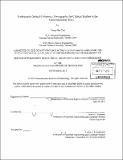Endoscopic optical coherence tomography for clinical studies in the gastrointestinal tract
Author(s)
Tsai, Tsung-Han, Ph. D. Massachusetts Institute of Technology
DownloadFull printable version (31.29Mb)
Other Contributors
Massachusetts Institute of Technology. Department of Electrical Engineering and Computer Science.
Advisor
James G. Fujimoto.
Terms of use
Metadata
Show full item recordAbstract
Optical coherence tomography (OCT) performs micrometer-scale, cross-sectional and three dimensional imaging by measuring the echo time delay of backscattered light. OCT imaging is performed using low-coherence interferometry. With the development of Fourier domain detection techniques and fiber-optic based OCT endoscopes, high speed internal body imaging was enabled, which makes OCT suitable for clinical research in the human gastrointestinal (GI) tract. Endoscopic OCT imaging is challenging because fast and stable optical scanning must be implemented inside a small imaging probe to acquire useable volumetric information from internal human bodies. Although several studies have shown the use of endoscopic OCT in human gastrointestinal tracts as a real-time surveillance tool, the capability of OCT has not yet been fully explored in endoscopic applications and OCT is not well accepted as a standard imaging modality for GI clinics due to hardware limitations and lack of comprehensive clinical evidences. This thesis presents a number of clinical studies using endoscopic OCT that provide solutions to clinical problems in the GI tract supported by statistically significant results and the development of ultrahigh speed endoscopic OCT system that enables advanced OCT imaging applications. In collaboration with medical partners, the structural features in the diseased esophagus identified from OCT images are compared before and immediately after different ablative therapies, and features that predict the treatment response are investigated. Working in collaboration with industrial partners, an ultrahigh speed endoscopic OCT imaging system is constructed for clinical research in gastroenterology. Distally actuated imaging catheters are developed, enabling the visualization of the detailed three-dimensional (3D) structure in the gastrointestinal tract. Finally, clinical pilot studies are conducted and demonstrate the utility of the ultrahigh speed endoscopic OCT imaging for broader surveillance coverage, pathology detection, and dye-less contrast enhancement. The convergence of 3D spatial resolution, imaging speed, field of view, and minimally invasive access enabled by endoscopic OCT are unmatched by most other biomedical imaging techniques. Though still in its early stage of clinical validation, endoscopic OCT may have a profound impact on human healthcare and industrial inspection by enabling visualization and quantification of 3D microstructure in situ and in real time.
Description
Thesis (Ph. D.)--Massachusetts Institute of Technology, Department of Electrical Engineering and Computer Science, 2013. Cataloged from PDF version of thesis. Includes bibliographical references.
Date issued
2013Department
Massachusetts Institute of Technology. Department of Electrical Engineering and Computer SciencePublisher
Massachusetts Institute of Technology
Keywords
Electrical Engineering and Computer Science.